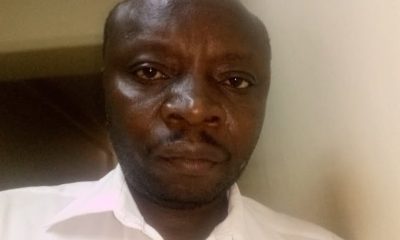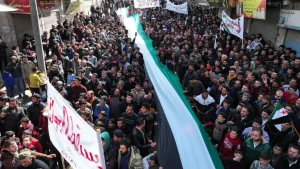News
From Syrian Jihadist Leader To Rebel Politician: How Abu Mohammed al-Jawlani Reinvented Himself
Jawlani’s transformation is not recent, but has been carefully cultivated over the years, evident not only in his public statements and interviews with international outlets but also in his evolving appearance.

BBC—Syrian rebel leader Abu Mohammed al-Jawlani has dropped that nom de guerre associated with his jihadist past, and been using his real name, Ahmed al-Sharaa, in official communiques issued since Thursday, ahead of the fall of President Bashar al-Assad.
This move is part of Jawlani’s effort to bolster his legitimacy in a new context, as his Islamist militant group, Hayat Tahrir al-Sham (HTS), leading other rebel factions, announces the capture of the Syrian capital, Damascus, solidifying its control over much of the country.
Jawlani’s transformation is not recent, but has been carefully cultivated over the years, evident not only in his public statements and interviews with international outlets but also in his evolving appearance.
Once clad in traditional jihadist militant attire, he has adopted a more Western-style wardrobe in the past years. Now, as he leads the offensive, he has donned military fatigues, symbolising his role as the commander of the operations room.
But who is Jawlani – or Ahmed al-Sharaa – and why and how has he changed?
The IS-Iraq link
A 2021 PBS interview with Jawlani revealed that he was born in 1982 in Saudi Arabia, where his father worked as an oil engineer until 1989.
In that year, the Jawlani family returned to Syria, where he grew up and lived in the Mezzeh neighbourhood of Damascus.
Jawlani’s journey as a jihadist began in Iraq, linked to al-Qaeda through the Islamic State (IS) group’s precursor – al-Qaeda in Iraq and, later, the Islamic State of Iraq (ISI).
After the 2003 US-led invasion, he joined other foreign fighters in Iraq and, in 2005, was imprisoned at Camp Bucca, where he enhanced his jihadist affiliations and later on was introduced to Abu Bakr al-Baghdadi, the quiet scholar who would later go on to lead IS.
In 2011, Baghdadi sent Jawlani to Syria with funding to establish al-Nusra Front, a covert faction tied to ISI. By 2012, Nusra had become a prominent Syrian fighting force, hiding its IS and al-Qaeda ties.
Tensions arose in 2013 when Baghdadi’s group in Iraq unilaterally declared the merger of the two groups (ISI and Nusra), declaring the creation of the Islamic State of Iraq and the Levant (ISIL or ISIS), and publicly revealing for the first time the links between them.
Jawlani resisted, as he wanted to distance his group from ISI’s violent tactics, leading to a split.
To get out of that sticky situation, Jawlani pledged allegiance to al-Qaeda, making Nusra Front its Syrian branch.
From the start, he prioritised winning Syrian support, distancing himself from IS’s brutality and emphasising a more pragmatic approach to jihad.
Joining al-Qaeda
In April 2013, al-Nusra Front became al-Qaeda’s Syrian affiliate, putting it at odds with IS.
While Jawlani’s move was partly an attempt to maintain local support and avoid alienating Syrians and rebel factions, the al-Qaeda affiliation ultimately did little to benefit this effort.
It became a pressing challenge in 2015 when Nusra and other factions captured Idlib province, forcing them to co-operate in its administration.

Jawlani rebranded al-Nusra Front as Jabhat Fatah al-Sham in 2016. The following year it became Hayat Tahrir al-Sham.
In 2016, Jawlani severed ties with al-Qaeda, rebranding the group as Jabhat Fatah al-Sham and later as Hayat Tahrir al-Sham (HTS) in 2017.
While initially appearing superficial, the split revealed deeper divisions. Al-Qaeda accused Jawlani of betrayal, leading to defections and the formation of Hurras al-Din, a new al-Qaeda affiliate in Syria, which HTS later crushed in 2020. Members of Hurras al-Din, however, have remained cautiously present in the region.
HTS also targeted IS operatives and foreign fighters in Idlib, dismantling their networks and forcing some to undergo “deradicalisation” programmes.
These moves, justified as efforts to unify militant forces and reduce infighting, signalled Jawlani’s strategy to position HTS as a dominant and politically viable force in Syria.
Despite the public split from al-Qaeda and name changes, HTS continued to be designated by the UN, US, UK and other countries as a terrorist organisation, and the US maintained a $10m reward for information about Jawlani’s whereabouts. Western powers considered the break-up to be a façade.
Forming a ‘government’ in Idlib
Under Jawlani, HTS became the dominant force in Idlib, north-west Syria’s largest rebel stronghold and home to about four million people, many of whom were displaced from other Syrian provinces.
To address concerns about a militant group governing the area, HTS established a civilian front, the so-called “Syrian Salvation Government” (SG) in 2017 as its political and administrative arm.
The SG functioned like a state, with a prime minister, ministries and local departments overseeing sectors such as education, health and reconstruction, while maintaining a religious council guided by Sharia, or Islamic law.

Jawlani was pictured looking at a painting of the Umayyad Mosque during a visit to a book, arts and culture fair in Idlib in 2022
To reshape his image, Jawlani actively engaged with the public, visiting displacement camps, attending events, and overseeing aid efforts, particularly during crises like the 2023 earthquakes.
HTS highlighted achievements in governance and infrastructure to legitimise its rule and demonstrate its ability to provide stability and services.
It has previously praised the Taliban, upon their return to power in 2021, lauding them as an inspiration and a model for effectively balancing jihadist efforts with political aspirations, including making tactical compromises to achieve their goals.
Jawlani’s efforts in Idlib reflected his broader strategy to demonstrate HTS’s ability not only to wage jihad but also to govern effectively.
By prioritising stability, public services and reconstruction, he aimed to showcase Idlib as a model of success under HTS rule, enhancing both his group’s legitimacy and his own political aspirations.
But under his leadership, HTS has crushed and marginalised other militant factions, both jihadists and rebel ones, in its effort to consolidate its power and dominate the scene.
Anti-HTS protests
For over a year leading up to the HTS-led rebel offensive on 27 November, Jawlani faced protests in Idlib from hardline Islamists as well as Syrian activists.
Critics compared his rule to Assad’s, accusing HTS of authoritarianism, suppressing dissent and silencing critics. Protesters labelled HTS’s security forces as “Shabbiha”, a term used to describe Assad’s loyalist henchmen.
They further alleged that HTS deliberately avoided meaningful combat against government forces and marginalised jihadists and foreign fighters in Idlib to prevent them from engaging in such actions, all to appease international actors.
Even during the latest offensive, activists have persistently urged HTS to release individuals imprisoned in Idlib allegedly for expressing dissent.
In response to these criticisms, HTS initiated several reforms over the past year. It disbanded or rebranded a controversial security force accused of human rights violations and established a “Department of Grievances” to allow citizens to lodge complaints against the group. Its critics said these measures were just a show to contain dissent.
To justify its consolidation of power in Idlib and the suppression of plurality among militant groups, HTS argued that unifying under a single leadership was crucial for making progress and ultimately overthrowing the Syrian government.
HTS and its civilian arm, the SG, walked a tightrope, striving to project a modern, moderate image to win over both the local population and the international community, while simultaneously maintaining their Islamist identity to satisfy hardliners within rebel-held areas and HTS’s own ranks.
For instance, in December 2023, HTS and the SG faced a backlash after a “festival” held at a glossy new shopping mall was criticised by hardliners as “immoral”.
And this August, a Paralympic Games-inspired ceremony drew sharp criticism from hardliners, prompting the SG to review the organisation of such events.
These incidents illustrate the challenges HTS faces in reconciling the expectations of its Islamist base with the broader demands of the Syrian population, who are seeking freedom and coexistence after years of authoritarian rule under Assad.
Leading a new path?
As the latest offensive unfolded, global media focused on Jawlani’s jihadist past, prompting some rebel supporters to call for him to step back, viewing him as a liability.
Although he previously expressed willingness to dissolve his group and step aside, his recent actions and public appearances tell a different story.
HTS’s success in uniting rebels and nearly capturing the whole country in under two weeks has strengthened Jawlani’s position, quieting hardline critics and accusations of opportunism.
Jawlani and the SG have since reassured domestic and international audiences.
To Syrians, including minorities, they promised safety; to neighbours and powers like Russia, they pledged peaceful relations. Jawlani even assured Russia its Syrian bases would remain unharmed if attacks ceased.
This shift reflects HTS’s “moderate jihad” strategy since 2017, emphasising pragmatism over rigid ideology.
Jawlani’s approach could signal the decline of global jihad movements like IS and al-Qaeda, whose inflexibility is increasingly seen as ineffective and unsustainable.
His trajectory might inspire other groups to adapt, marking either a new era of localised, politically flexible “jihadism” or just a temporary divergence from the traditional path in order to make political and territorial gains.
Kenya Insights allows guest blogging, if you want to be published on Kenya’s most authoritative and accurate blog, have an expose, news TIPS, story angles, human interest stories, drop us an email on [email protected] or via Telegram
-

 Business2 weeks ago
Business2 weeks agoSAFARICOM’S M-SHWARI MELTDOWN: TERRIFIED KENYANS FLEE AS BILLIONS VANISH INTO DIGITAL BLACK HOLE
-

 Business2 weeks ago
Business2 weeks agoLloyd Masika Probed for Fraud as Stanbic Bank Exposed for Incompetence in Due Diligence
-

 News1 week ago
News1 week agoHow A Fake Firm Was Awarded A Sh230 Million Tender By Kiambu County
-

 News1 week ago
News1 week agoLANDLORD FROM HELL: Daniel Agili Ojijo’s Empire of Evictions, Unpaid Wages, and Sham Auctions Leaves Trail of Terrorized Tenants
-

 Business1 week ago
Business1 week agoSafaricom Blocks Telegram Access in Kenya
-

 News2 weeks ago
News2 weeks agoTop Lawyers Unite to Oust Justice Wasilwa After Police Recruitment Ruling
-

 Business2 weeks ago
Business2 weeks agoEXPOSED: How A 20-Year-Old University Student Breached Sidian Bank’s Security Fortress and Walked Away With KSh 7.8 Million
-

 News7 days ago
News7 days agoUK-Based Website Faces Scrutiny Over Alleged Sexual Exploitation Of Kenyan Women



































